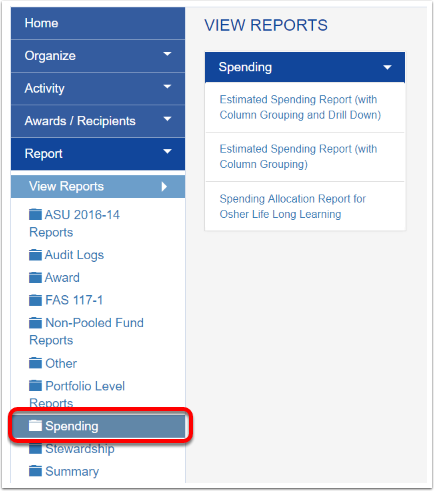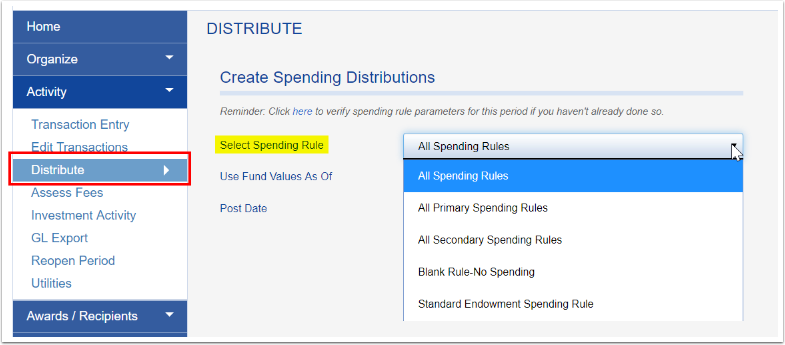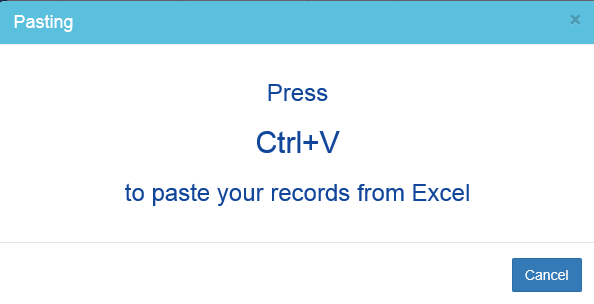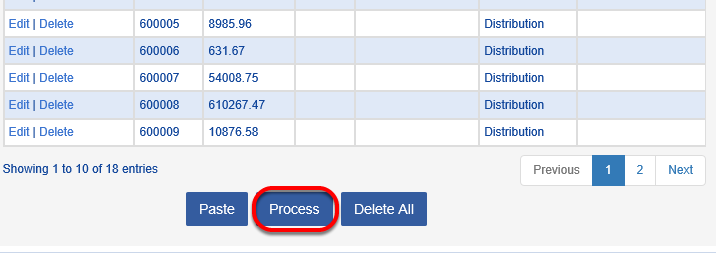Distributions using the Automated Method

Once you have verified that the spending rule parameters are set correctly, you can have Fundriver debit each individual fund for its spending amount. The automated method can be used to debit funds for the spending amount and set up to work with your withdrawal schedule. For example, if the annual payout rate is 5% and you want to debit funds quarterly using this AUTOMATED METHOD, you would change the Withdrawal parameter POSTING FREQUENCY to QUARTERLY, then CREATE DISTRIBUTIONS during the period the cash is drawn down. See above for example spending rule.

Click on one of your Estimated Spending Reports to run and then select RUN REPORT. We recommend running the Estimated Spending Report with Column Grouping and Drill Down. Verify that funds are assigned to the correct rule and do a spot check to ensure your total distributions equal your typical annual draw.
Once you've verified that the Estimated Spending amounts are accurate, proceed to next step.

- All Spending Rules
- All Primary Spending Rules
- All Secondary Spending Rules
Once you have selected a spending rule rule from the dropdown, select a date from the Use Fund Values As Of dropdown. The Use Fund Values As Of should mirror your allocation date on the spending rule set-up page.


Your distributions will be created based on the spending parameters you have set up. See the end of this document for a report you can run to review your distributions.

Distributions using the Manual Method

Choose the TRANSACTION TYPE > DISTRIBUTION and enter amount and any other information you would like available on the transaction record.

Click SAVE.
Distributions using the Flexible Method
Once you have your desired distributions amounts for each GLID formatted in excel you can bring in the data in bulk.

Click on the COPY FROM EXCEL tab and choose the DISTRIBUTION transaction type.

Your excel file should contain only GLID and GROSS DISTRIBUTION. You can add two additional columns for NOTES and SPENDING/INCOME ACCOUNT NUMBER (Destination). Populate these columns if you would like the information to reflect in the transaction record. They can also be left blank.
Note: If you have funds that are scheduled to reinvest either to market value or principal, you must take the additional step of adding in these transactions manually or using Copy from Excel. Funds that are reinvesting to market value should have a TRANSACTION TYPE of EXTERNAL TRANSFER IN and funds reinvesting to principal should have an INCOME TO PRINCIPAL type.


You will see the message below. Click Ctrl + V to paste.

Your data will populate the table on the IMPORT TRANSACTIONS FROM EXCEL screen. Edit or delete any distributions you notice are incorrect.

Once all data is correct, click the PROCESS button.

Exceptions that cannot be processed will remain in the table with a corresponding ERROR MESSAGE. A blank table means all records were properly processed.

Reviewing Distributions

